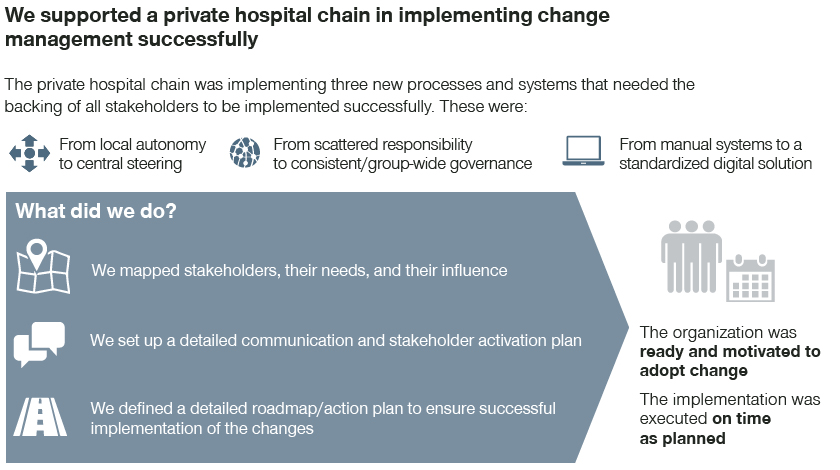So, you’ve optimized your self-pay offering and pricing strategy, and have standardized and professionalized your pricing and quoting processes: What now? In the final part of our series experts Christian Rebholz, Michael Keller, and Tim Kohtes explain how private hospitals can put all of the above into practice through effective change management.
So far in our series we outlined the strategies private hospitals must put in place to ensure growth in self-pay healthcare. Yet, without effective change management, successfully implementing the new concepts and realizing the upside potential is impossible.
The initiatives we previously outlined imply substantial changes in how an organization thinks and operates. As such, it requires a lot of heavy lifting from every stakeholder for the change to fuel growth.
In fact, many organizations fail to implement new approaches successfully and never realize the full potential of the new solutions. That said, successful transformation is possible if enacted properly.
Change management in private healthcare: Why is it important?
Transforming any organization is a difficult task and many change management efforts fail to convince stakeholders. As a result, planned goals and growth objectives cannot be achieved.
The standardization and professionalization of the quoting process, as outlined in Part 3 of our article series, fundamentally changes the way a private hospital’s sales team will operate. Instead of manual and individualized processes, a software solution will assist the sales team’s daily operations.
Naturally, members of the team will feel uncertain about their new daily routine: “Is it easy enough for me to use?”, “Is it truly reliable?”, “Will it eventually replace me?”. Effective change management can help the organization overcome such concerns and, instead, spark enthusiasm for more effective ways of working.
In Part 2 of our article series, we elaborated the benefits of a centralized self-pay pricing strategy. While well-conceived self-pay prices and group-wide pricing guidelines clearly provide the opportunity to drive better growth for the entire private hospital chain, it may create fear among hospital directors that decision-power is being taken away from them.
In worst cases, stakeholders may resist and actively undermine the change. Again, effective change management is necessary to illustrate to hospital directors (who are responsible for the P&L of their site) that it’s not about taking decision-power away but supporting them with value capture opportunities.
So, overall, there’s an opportunity here for private hospitals to activate, build trust, and provide the organization with the needed assistance to adapt. Only if the change is fully internalized and supported by all stakeholders will it lead to a sustainable impact for the organization.
Three steps to successfully implementing change management
- Identify critical stakeholders for success
What is required to bring your new revenue management concept to action? The simple answer lies in gaining the support of your stakeholders.
As we mentioned above, stakeholders can be roadblocks to revenue management transformation, if the change creates unresolved uncertainty and resistance. As such, it’s crucial to outline the needs and concerns of each stakeholder group to identify what is required for them to support the change.
That’s why creating stakeholder profiles is key. These will enable you to identify the stakeholder groups that are crucial to prioritize for change. Moreover, they will allow you to customize your communication style and content to the needs of each stakeholder.
- Support all stakeholders in successfully internalizing the change
Every stakeholder needs to pass four milestones to successfully internalize the change.
In the first phase of the change management process (awareness), a compelling case needs to be created that makes the reasons for change obvious.
In the second phase (motivation), the stakeholders’ desire to embrace the change needs to be nurtured. An internal belief that the transition will be successful needs to be created. In phase three (capability), the organization needs to provide sufficient tools and time to develop new skills and support the behavioral change. In the last stage (reinforcement), the change needs to be sustained to stop stakeholders from using workarounds and falling back into old habits.
The level of engagement needs to be aligned to the role of each stakeholder: One communication activity may accomplish multiple objectives for less relevant/affected stakeholders. Multiple iterations may be required to accomplish one objective for crucial stakeholders.
- Develop a detailed change management plan
Finally, an action plan needs to be set-up that clearly defines activities, deadlines, and responsibilities to bring the new way of working to life.
The change management plan transparently outlines how, when and by whom the mitigation from the status quo to the new way of working will be carried out. It clearly assigns roles and responsibilities and gives operational guidance to drive the change. In addition to specialists who are responsible for specific work packages, there needs to be a central change management team that coordinates the entire roll-out and reinforces the new operating model. A transparent and comprehensible roadmap will ensure that the entire organization feels confident in the steps required and understands what results are expected by when. As such, the change management plan provides clarity and a common vision on how to make the change successful.
How we’ve helped

________
Read more from our series:
Part 1: How Private Hospitals can Improve their Self-Pay Healthcare Offering
Part 2: How Private Hospitals can Optimize their Self-Pay Healthcare Prices
Part 3: How Private Hospitals can Grow Self-Pay Business via a Streamlined Sales Process








